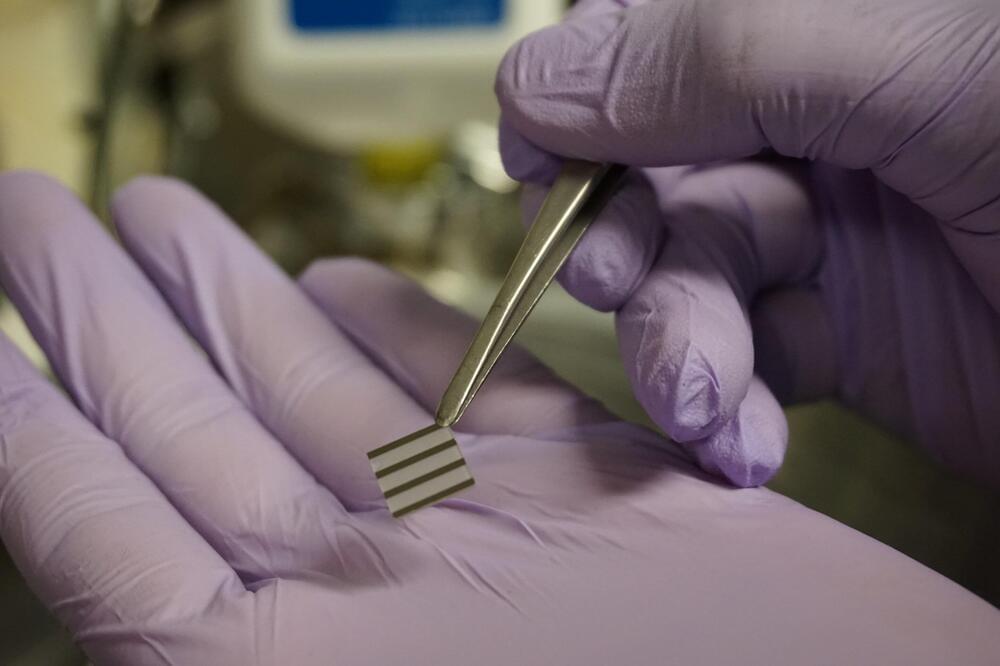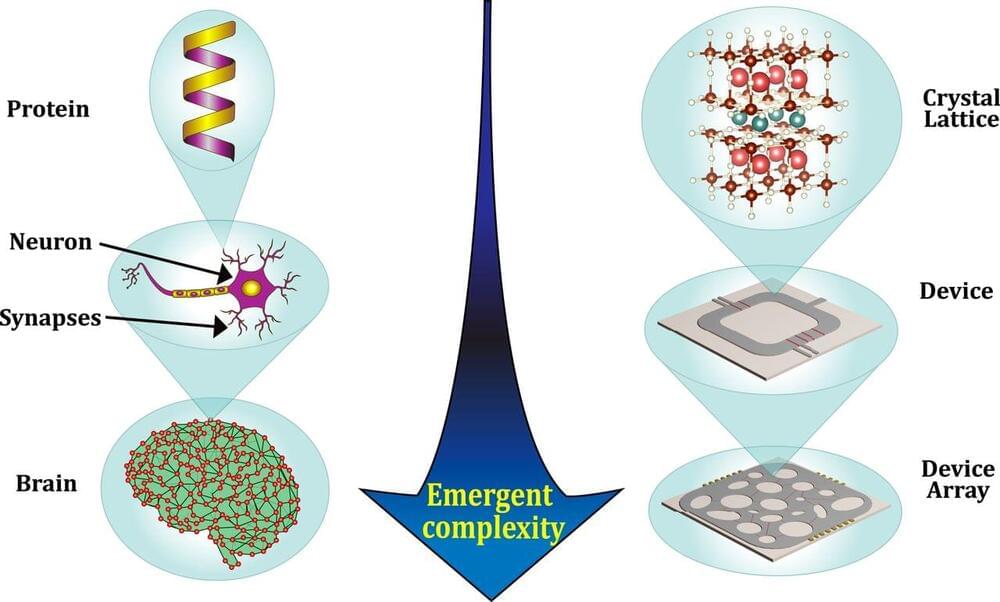Archive for the ‘quantum physics’ category: Page 444
Sep 14, 2021
Taking lessons from a sea slug, study points to better hardware for artificial intelligence
Posted by Kelvin Dafiaghor in categories: information science, quantum physics, robotics/AI
A new study has found that a material(nickel oxide, a quantum material) can mimic the sea slug’s most essential intelligence features. The discovery is a step toward building hardware that could help make AI more efficient and reliable.
For artificial intelligence to get any smarter, it needs first to be as intelligent as one of the simplest creatures in the animal kingdom: the sea slug.
A new study has found that a material can mimic the sea slug’s most essential intelligence features. The discovery is a step toward building hardware that could help make AI more efficient and reliable for technology ranging from self-driving cars and surgical robots to social media algorithms.
Sep 14, 2021
Futuristic AI-Based Computing Devices: Physicists Simulate Artificial Brain Networks With New Quantum Materials
Posted by Genevieve Klien in categories: biotech/medical, quantum physics, robotics/AI, supercomputing
Pandemic lockdown forces a new perspective on designs for futuristic AI-based computing devices.
Isaac Newton’s groundbreaking scientific productivity while isolated from the spread of bubonic plague is legendary. University of California San Diego physicists can now claim a stake in the annals of pandemic-driven science.
A team of UC San Diego researchers and colleagues at Purdue University have now simulated the foundation of new types of artificial intelligence computing devices that mimic brain functions, an achievement that resulted from the COVID-19 pandemic lockdown. By combining new supercomputing materials with specialized oxides, the researchers successfully demonstrated the backbone of networks of circuits and devices that mirror the connectivity of neurons and synapses in biologically based neural networks.
Sep 13, 2021
Low-temperature emergent neuromorphic networks with correlated oxide devices
Posted by Saúl Morales Rodriguéz in categories: quantum physics, robotics/AI
Designing neuromorphic hardware for cryoelectronics is an important area of research as the field of computing paradigms beyond complementary metal-oxide-semiconductor (CMOS) progresses. Superconductivity and metal−insulator transitions are two of the most celebrated emergent, collective properties found in quantum materials such as strongly correlated oxides. Here, we present simulations of artificial neural networks that can be designed by combining superconducting devices (e.g. Josephson junctions) with Mott metal−insulator transition−based tunable resistor devices. Our simulations show that 1) neurons and synapses can be seamlessly created, 2) their functions can be tuned via learning, and 3) controlling disorder by incorporating light ions enables exponential multiplicity of states. The results open up directions for incorporating emergent behavior seen in condensed matter into hardware design for artificial intelligence.
Neuromorphic computing—which aims to mimic the collective and emergent behavior of the brain’s neurons, synapses, axons, and dendrites—offers an intriguing, potentially disruptive solution to society’s ever-growing computational needs. Although much progress has been made in designing circuit elements that mimic the behavior of neurons and synapses, challenges remain in designing networks of elements that feature a collective response behavior. We present simulations of networks of circuits and devices based on superconducting and Mott-insulating oxides that display a multiplicity of emergent states that depend on the spatial configuration of the network. Our proposed network designs are based on experimentally known ways of tuning the properties of these oxides using light ions. We show how neuronal and synaptic behavior can be achieved with arrays of superconducting Josephson junction loops, all within the same device.
Sep 13, 2021
Time-magnified photon counting with 550-fs resolution
Posted by Saúl Morales Rodriguéz in categories: computing, nanotechnology, quantum physics
Time-resolved photon counting plays an indispensable role in precision metrology in both classical and quantum regimes. Therein, time-correlated single-photon counting (TCSPC) [1] has been the key enabling technology for applications such as fluorescence lifetime microscopy [2], time-gated Raman spectroscopy [3], photon counting time-of-flight (ToF) 3D imaging [4], light-in-flight imaging [5], and computational diffuse optical tomography [6]. For all these applications, one of the most important figures of merit is the single-photon timing resolution (SPTR, also referred to as photon counting timing jitter). The TCSPC SPTR is limited by the available single-photon detectors. For example, photomultiplier tubes typically provide an SPTR larger than 100 ps [7]. Meanwhile, superconducting nanowire single-photon detectors have superior SPTR in the sub-10-ps range [8, 9]. However, cryogenic cooling significantly increases the system complexity. Single-photon avalanche diodes (SPADs) operate at moderate temperature, which makes them a popular choice for various applications mentioned above. Nevertheless, their SPTR is still limited to tens-of-picoseconds level [10]. On the other hand, orders-of-magnitude enhancement on SPTR is required for many challenging applications such as the study of ultrafast fluorescent decay dynamics [11,12].
In this Letter, we demonstrate a time-magnified TCSPC (TM-TCSPC) that achieves an ultrashort SPTR of 550 fs using an off-the-shelf single-photon detector. The key component is a quantum temporal magnifier using a low-noise high-efficiency fiber parametric time lens [13,14] based on four-wave mixing Bragg scattering (FWM-BS) [15 – 17]. A temporal magnification of 130 with a 97% photon conversion efficiency has been achieved while maintaining the quantum coherence of the signal under test (SUT). Detection sensitivity of -{95}\;rm{dBm}$ (0.03 photons per pulse), limited by the spontaneous Raman scattering noise, is possible and allows efficient processing and characterization of quantum-level SUT. The TM-TCSPC can resolve ultrashort pulses with a 130-fs pulse width difference at a 22-fs accuracy. When applied to photon counting ToF 3D imaging, the TM-TCSPC greatly suppresses the range walk error (RWE) that limits all photon counting ToF 3D imaging systems by 99.2% (130 times) and thus provides high depth measurement accuracy and precision of 26 µm and 3 µm, respectively. The TM-TCSPC is a promising solution for photon counting at the femtosecond regime that will benefit various research fields such as fluorescence lifetime microscopy, time-gated Raman spectroscopy, light-in-flight imaging, and computational diffuse optical tomography.
Sep 13, 2021
By confining the transport of electrons and ions, scientists show they can alter material properties
Posted by Saúl Morales Rodriguéz in categories: materials, quantum physics
Like ripples in a pond, electrons travel like waves through materials, and when they collide and interact, they can give rise to new and interesting patterns.
Scientists at the U.S. Department of Energy’s (DOE) Argonne National Laboratory have seen a new kind of wave pattern emerge in a thin film of metal oxide known as titania when its shape is confined. Confinement, the act of restricting materials within a boundary, can alter the properties of a material and the movement of molecules through it.
In the case of titania, it caused electrons to interfere with each other in a unique pattern, which increased the oxide’s conductivity, or the degree to which it conducts electricity. This all happened at the mesoscale, a scale where scientists can see both quantum effects and the movement of electrons and molecules.
Sep 13, 2021
Researchers develop new tool for analyzing large superconducting circuits
Posted by Saúl Morales Rodriguéz in categories: quantum physics, supercomputing
The next generation of computing and information processing lies in the intriguing world of quantum mechanics. Quantum computers are expected to be capable of solving large, extremely complex problems that are beyond the capacity of today’s most powerful supercomputers.
New research tools are needed to advance the field and fully develop quantum computers. Now Northwestern University researchers have developed and tested a theoretical tool for analyzing large superconducting circuits. These circuits use superconducting quantum bits, or qubits, the smallest units of a quantum computer, to store information.
Circuit size is important since protection from detrimental noise tends to come at the cost of increased circuit complexity. Currently there are few tools that tackle the modeling of large circuits, making the Northwestern method an important contribution to the research community.
Sep 13, 2021
Quantum mechanics for plants
Posted by Quinn Sena in categories: economics, energy, quantum physics
Circa 2004
To what extent do photosynthetic organisms use quantum mechanics to optimize the capture and distribution of light? Answers are emerging from the examination of energy transfer at the submolecular scale.
The first law of photosynthetic economics is: “A photon saved is a photon earned.” Research into the factors behind this principle has been burgeoning, and has recently culminated in a paper in Physical Review Letters by Jang et al.1 in which the authors look at photosynthetic energy transfer at the quantum level.
Sep 12, 2021
Atomically-Thin, Twisted Graphene Has Unique Properties That Could Advance Quantum Computing
Posted by Genevieve Klien in categories: computing, quantum physics
Researchers describe how electrons move through two-dimensional layered graphene 0 findings that could lead to advances in the design of future quantum computing platforms.
New research published in Physical Review Letters describes how electrons move through two different configurations of bilayer graphene, the atomically-thin form of carbon. This study, the result of a collaboration between Brookhaven National Laboratory, the University of Pennsylvania, the University of New Hampshire, Stony Brook University, and Columbia University 0 provides insights that researchers could use to design more powerful and secure quantum computing platforms in the future.
“Today’s computer chips are based on our knowledge of how electrons move in semiconductors, specifically silicon,” says first and co-corresponding author Zhongwei Dai, a postdoc at Brookhaven. “But the physical properties of silicon are reaching a physical limit in terms of how small transistors can be made and how many can fit on a chip. If we can understand how electrons move at the small scale of a few nanometers in the reduced dimensions of 2-D materials, we may be able to unlock another way to utilize electrons for quantum information science.”
Sep 12, 2021
Cumrun Vafa: String Theory | Lex Fridman Podcast #204
Posted by Alan Jurisson in categories: evolution, mathematics, quantum physics, space

Cumrun Vafa is a theoretical physicist at Harvard. Please support this podcast by checking out our sponsors:
- Headspace: https://headspace.com/lex to get free 1 month trial.
- The Jordan Harbinger Show: https://www.youtube.com/thejordanharbingershow.
- Squarespace: https://lexfridman.com/squarespace and use code LEX to get 10% off.
- Allform: https://allform.com/lex to get 20% off.
CORRECTIONS:
- I’m currently hiring folks to help me with editing and image overlays so there may be some errors in overlays (as in this episode) as we build up a team. I ask for your patience.
- At 1 hour 27 minute mark, we overlay an image of Brian Greene. We meant to overlay an image of Michael Green, an early pioneer of string theory: https://bit.ly/michael-green-physicist.
- The image overlay of the heliocentric model is incorrect.
Continue reading “Cumrun Vafa: String Theory | Lex Fridman Podcast #204” »

















